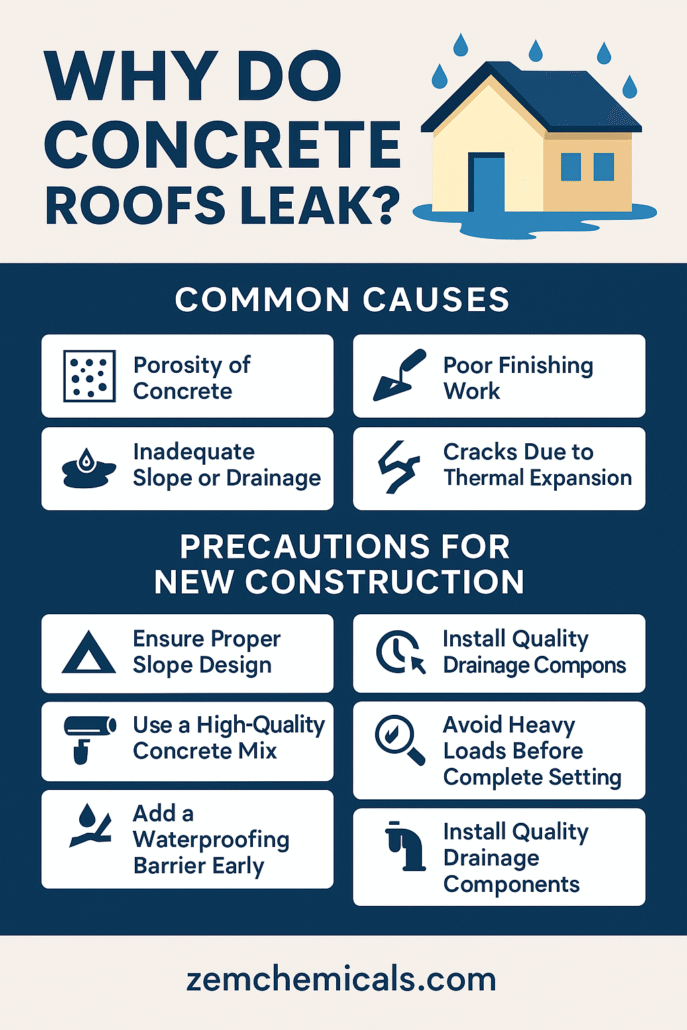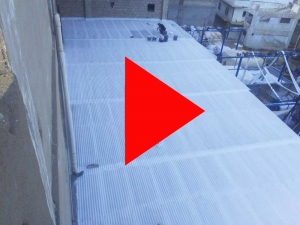Why Do Concrete Roofs Leak? Key Causes and Precautions Before Finishing New Roof Construction
Concrete roofs are widely used in Karachi due to their strength, durability, and suitability for flat-roofed construction. However, over time, many homeowners face the frustrating problem of water leakage from these structures. Understanding why concrete roofs leak and the importance of applying concrete roof waterproofing during construction can save significant repair costs in the future.

Common Causes of Concrete Roof Leaks
Even though concrete is a robust building material, it is not entirely waterproof. Tiny pores in the material allow water to seep in slowly, especially when exposed to frequent rains, high humidity, or temperature changes. Below are the key reasons why concrete roofs often leak:
-
Porosity of Concrete: Despite its solid appearance, concrete contains microscopic pores. These pores absorb water like a sponge, leading to eventual seepage through the roof structure.
-
Poor Slope Design: A flat concrete roof without a proper drainage slope can result in water stagnation. Pooled water adds weight and increases the chance of leaks and structural damage.
-
Cracks from Expansion & Contraction: Karachi’s weather can swing from extreme heat to unexpected rain showers. These temperature variations cause the concrete to expand and contract, leading to visible or invisible cracks over time. That’s why implementing roof waterproofing solutions becomes essential even before the finishing phase.
-
Low-Quality Construction Materials: Substandard concrete mix or improper application can compromise the roof’s integrity. In such cases, even the slightest rain may result in seepage.
-
Neglected Roof Waterproofing: Many homeowners overlook the importance of adding a waterproof barrier during the roof’s construction. Without this protection, concrete remains vulnerable to weather damage.
-
Blocked or Poor Drainage Systems: Clogged water outlets and downpipes cause water buildup, which eventually finds its way into tiny cracks and porous areas of the roof.
Precautions for New Roof Construction
If you’re constructing a new house or replacing an old roof, taking these measures can help prevent future leakage:
-
Plan the Drainage Slope from Day One: The first and most crucial step is to ensure that your concrete roof has a visible slope (at least 1:100 ratio) directing water to properly installed drainage points.
-
Use High-Quality Concrete Mix: A strong foundation starts with the right materials. Make sure your contractor uses a well-mixed, high-strength concrete formula to avoid weak spots.
-
Apply Roof Waterproofing at the Right Stage: One of the best practices is to apply a liquid membrane or waterproofing sheet after the concrete has cured but before any tile or finishing layer is applied. Proper roof waterproofing reduces the risk of water penetration through the slab.
-
Avoid Heavy Loading in Early Days: Do not place heavy water tanks, construction materials, or HVAC equipment on the roof until the concrete has completely set and cured.
-
Install Drainage Systems Carefully: Make sure all outlets, pipes, and downspouts are properly aligned and free of blockage. A single blocked outlet can flood the roof within minutes during Karachi’s monsoon rains.
-
Conduct Water Pond Testing: After roof casting, perform a 48-hour water pond test to check for early leaks. It’s easier and cheaper to fix issues before finishing layers are added.
-
Add Concrete Roof Waterproofing Products Early: During construction, applying chemical waterproofing admixtures into the concrete mix or spraying surface waterproofing solutions ensures long-term resistance against seepage.
Conclusion
Concrete roofs are a great investment when built with care and precision. However, understanding the root causes of leakage and implementing essential construction precautions — including concrete roof waterproofing and well-planned roof waterproofing strategies — can significantly increase their life and effectiveness. In Karachi’s unpredictable climate, roof maintenance is not just a seasonal chore — it is a preventive necessity.











